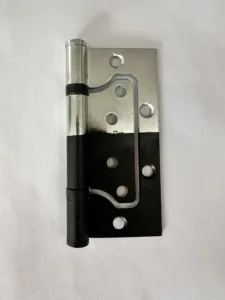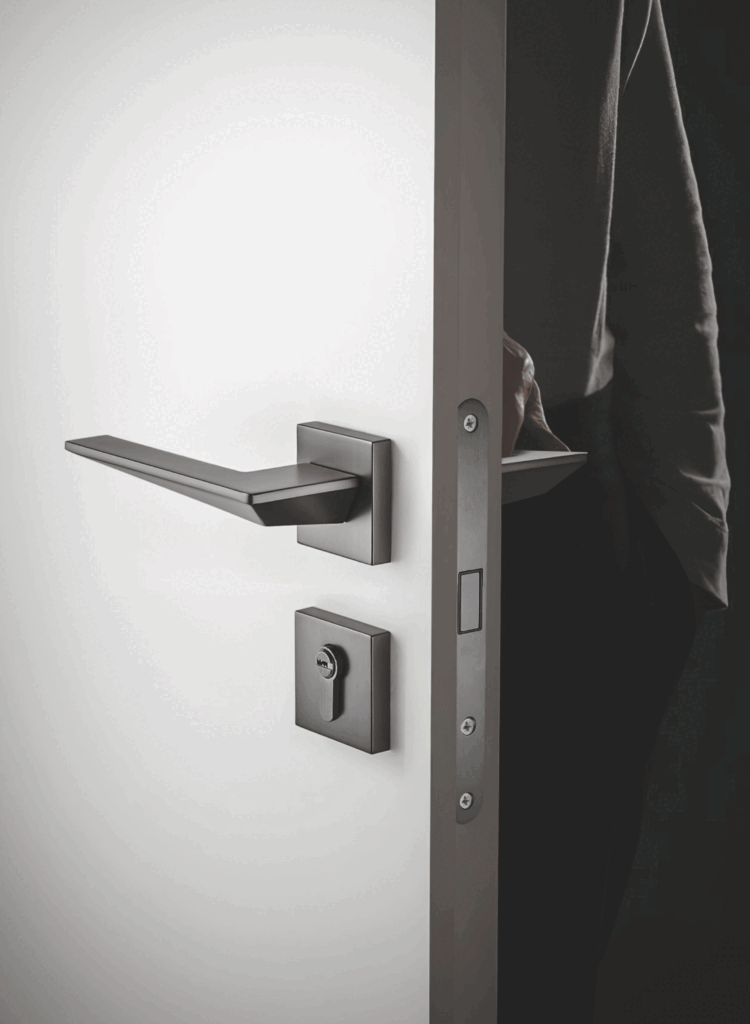What is a flush hinge?
A flush hinge is a compact, lightweight hinge designed primarily for interior doors. Unlike concealed or mortised hinges, it can be surface-mounted without cutting grooves into the door or frame — making installation faster and easier. It’s especially suitable for light to medium doors and is often used to eliminate gaps between the door and frame.
At Umaylock, we’ve worked with professional buyers for over 20 years. Here’s a clear comparison to help you understand how high-quality and low-quality flush hinges perform differently — and why it matters for your projects.
1. Material & Manufacturing Process
High-quality flush hinges are made from:
- 304 stainless steel or cold-rolled steel — highly resistant to corrosion and deformation.
- Zinc alloy (≥95% purity) with superior electroplating protection.
Their manufacturing involves:
- Precision stamping for smooth, burr-free edges and accurate hole alignment.
- Heat treatment of key parts like the pin and bearings (HRC 45–55) to reduce long-term wear.
Low-quality hinges, on the other hand, often use:
- Cheap alloys, thin steel sheets, or recycled materials that rust and deform easily.
- Crude stamping, resulting in visible burrs and misaligned holes.
No hardening, causing premature bearing wear or failure.
2. Structural Design & Functional Performance
Premium hinges typically feature:
- 3–4 independent ball bearings for smooth, quiet operation.
- Even weight distribution that improves lifespan by 2–3 times compared to single-pin designs.
Low-end products usually:
- Use plastic sleeves or single-axis pins, which wear quickly and cause friction.
Show signs of squeaking, misalignment, or door sagging after just a few months of use.
3. Mechanical Performance Metrics
Feature | High-Quality Hinge | Low-Quality Hinge |
Load Capacity | Supports ≥30 kg (light doors), 50+ kg (heavy doors) | Often overclaimed; actual <15 kg |
Cycle Life | Passes 100,000 cycles (EN 15570 standard) | Fails after 10,000–20,000 cycles |
Tensile Strength | Axle-to-leaf pull resistance ≥500N | Weak joints; prone to deformation or breakage |
For commercial buyers, especially in hospitality or residential complexes, a hinge’s mechanical integrity directly affects door performance and customer satisfaction.
4. Surface Finishing & Corrosion Resistance

High-end butt hinges feature:
- Multi-layer electroplating (e.g., nickel or copper), ≥8μm thickness.
- Salt spray test performance ≥72 hours, ideal for humid areas like bathrooms and kitchens.
- Powder coating with UV resistance for outdoor use.
Low-end hinges typically:
- Use cheap paint or thin plating.
- Rust within 3–6 months in humid environments.
- Lack adhesion and surface uniformity.
Want long-term peace of mind? Choose stainless steel or powder-coated hinges tested under ASTM B117 standards.
5. Compatibility, Safety, and Details
Top-tier hinges provide:
- Multiple sizing options, thicknesses, and finishes to fit various door designs.
- Heat-treated screws to avoid snapping during installation.
- Enhanced anti-loosening and anti-theft designs for high-traffic areas.
In contrast, basic models:
- Have limited fit, poor adjustability, and may require modification on-site.
Use brittle screws prone to breaking during torqueing.
6. Warranty & Certifications
Premium hinges should come with:
- 5–10 year warranties.
Cheaper alternatives:
- Rarely come with valid documentation.
- Often lack safety, toxicity, or performance testing, exposing your project to risk.
At Umaylock, our products are tested by global agencies like SGS, ensuring compliance with international standards.
Real-World Failures You Can Avoid
🔻 Door Sagging:
Low-quality hinges buckle under real loads. Within a year, gaps appear, misalignment worsens, and the door no longer closes properly. Our 3-bearing system prevents this.
🔻 Squeaking & Friction:
Noisy doors due to worn-out sleeves and unlubricated pins are a maintenance nightmare. Umaylock’s ball-bearing hinges operate silently, even after years of use.
🔻 Corrosion & Rust:
Cheap hinges corrode quickly in kitchens and bathrooms, loosening screws and even causing doors to fall. Our stainless steel and coated finishes ensure longevity.
Buyer’s Checklist: How to Choose the Right Hinge
- Check the Material
- Wet environments → 304 stainless steel
- Dry interiors → cold-rolled steel
- Avoid thin iron or recycled alloys.
- Wet environments → 304 stainless steel
- Test Load Capacity
- Door weight + 30% safety margin (e.g., 20kg door → 30kg hinge).
- Door weight + 30% safety margin (e.g., 20kg door → 30kg hinge).
- Feel the Motion
- Smooth opening with slight resistance (damping).
- No grinding, squeaks, or rattles.
- Smooth opening with slight resistance (damping).
Final Verdict: Pay More Now, Save More Later
High-quality hinges may cost 30–50% more upfront, but they reduce maintenance costs by 3–5x, prevent complaints, and ensure 10+ years of trouble-free use.
Whether you’re a wholesale distributor, door manufacturer, or project contractor, investing in better hinges pays off — and keeps your clients happy.
✅ Want reliable, tested hinges with global support?
👉 Visit Umaylock’s hinge collection and request a quote today.
Share This Story, Choose Your Platform!

